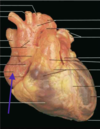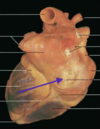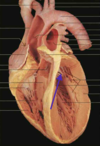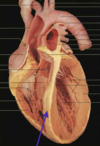Practical #1 Flashcards
(50 cards)

Right Ventricle

Left Ventricle

Right Atrium
Posterior-Lateral View

Left Atrium

Aorta

Pulmonary Trunk

Superior Vena Cava

Inferior Vena Cava

Pulmonary Veins

Pulmonary Valve

Aortic Valve

Mitral Valve (left AV)

Tricuspid Valve (right AV)

Papillary Muscle

Chordae tendineae

Interventricular Septum

Right Coronary Artery. comes off of aorta right above aortic valve

Left Coronary Artery. Comes off aorta right above valve.

Coronary Sinus. “connects” with the right atrium and lies in the AV groove posteriorly.
Smooth muscle that forms ridges in the heart. Easy to see in the atria.
Trabeculae carneae
First Heart Sound
Due to the closing of the AV valves which happens just as the ventricles start to contract.
Second Heart Sound
Due to the closing of the aorta and pulmonary valves and occurs as the ventricles begin to relax.
Murmurs Due to Valves
Turbulence. Stenosis is when valves do not open properly. Insufficiency is when valves do not close properly.
Where do you hear the aortic valve?
Right of the sternum in the 2nd intercostal space.




